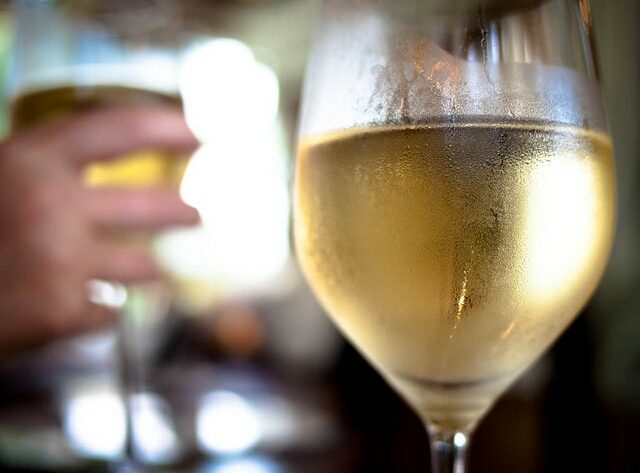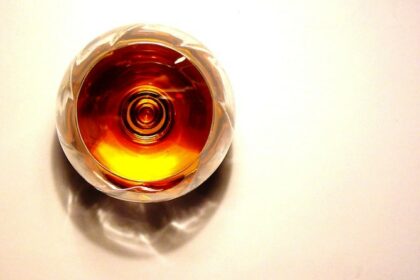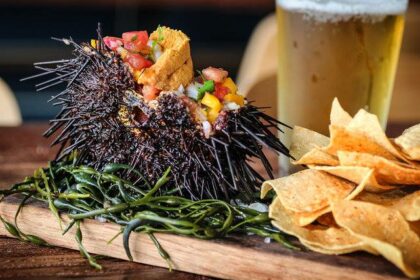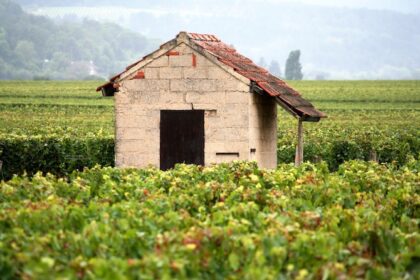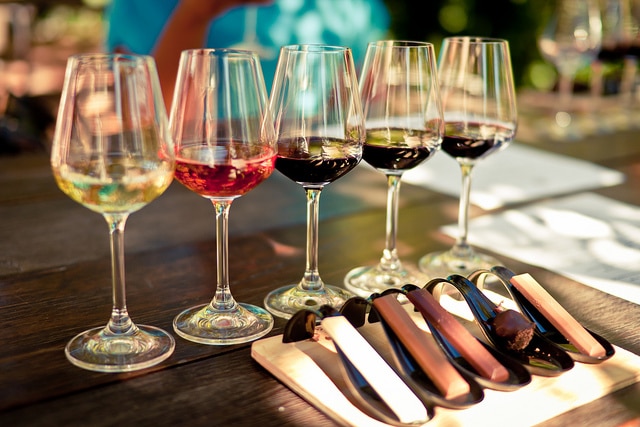
This is the first article in an original Epicure & Culture series, “Sommelier Certification,” where I will be documenting my experience obtaining a sommelier certification (as long as I pass) through the Sommelier Society of America. My goal is to not only show you what goes into getting this certification, but also expand your knowledge on topics relating to wine so you can hone your skills at identifying a Klein Constantia Vin de Constance or telling the difference between a Bourdeaux from California and a Bourdeaux from France.
The first three classes of the Sommelier Society of America certification program — there are 21 in all, each two hours long — cover the basics of wine tasting, including how to taste wine, tasting techniques, cooperage and the business of wine. Classes take place in the beautiful and private University Club of New York, with each session having a speaker take you through the day’s lesson. Students sit at long tables topped with a variety of wine samples to practice refining their palate, and although the dress code is tailored pants and dress shirts the atmosphere is surprisingly relaxed, allowing students to feel comfortable to ask questions in an ambient setting.
The Components Of Wine
To understand any wine topics it’s important to start from the beginning: the components of wine. One of the major points to comprehend when tasting wine is a wine’s quality isn’t based on whether it has a lot of tannins, high alcohol or full body, but whether the components that make up the wine — including tannins, acid, alcohol, body and sugar — are in balance. For example, tannins — small particles that come from grape skins, seeds and stalks or exposure to oak that give the wine backbone — must be just the right amount or a wine will feel flat (if too little) or may actually be tight and hard if too much. Additionally, sweetness, which should not be confused with fruitiness but should be thought of us perceived residual sugar, often thickens wine, leading it to feel rounder and less tart. Acidity is what will give the wine a tart essence, and can be used to balance sweetness and body. Typically, acidity and sugar counteract each other, as often the higher the residual sugar the lower the perceived acidity. And then there’s the body, or the weight of the wine on the tongue and the fullness you feel in your mouth, which helps dictate whether the wine is light and delicate or more rich. Often, extra tannins and/or high acidity is necessary to balance a full-bodied wine.
As you can see, these wine elements all work together to create a wine that is in balance. Alone these elements don’t dictate the quality of the wine — although a long-lasting finish is a good indicator you’ve got an excellent product — but how they work together and the amount of them does.

How To Identify Wine Components?
Isn’t it impressive when you see wine professionals take a sip of wine and start rattling off how tannic, acidic or full-bodied it is? There are certainly things that happen that are guiding them to these conclusions. With tannins, you’ll often feel like the moisture has been sucked out from your mouth or as if you’ve drank over-steeped tea. While this may not sound desirable, tannins are essential for giving a wine structure and firmness, contributing to the mouthfeel of the wine, and acting as a preservative that allows the wine to age gracefully. If you’ve ever had someone tell you not to open a bottle of wine right away — or possibly even a few years — it’s often because the wine is too tannic when it’s young, and over time will soften.
Acidity in wine can be identified by salivation, as it literally makes your mouth water. You’ll taste a tartness, and will feel a prickling on the sides of the tongue and behind the jaw. Usually the higher the acidity the dryer and less sweet a wine will seem, and the more “alive” it comes across as. Tip: The acidity level can often tell you what kind of climate a wine came from, as cooler climates tend to produce more acidic, earthy wines. This is because in warmer climates there is more sun, which leads to riper, more sugary fruits (which also provide more for yeast to metabolize, often leading to higher alcohol content and fuller body). On the other hand, cooler climates with less sun produce less sugary fruit, and tends to be less sweet and more acidic. That being said, chaptalization — or the process of adding sugar to unfermented grape must to give yeast more sugar to metabolize and turn to alcohol — is sometimes used by warm climate winemakers.
When deciphering the sugar content of a wine, it’s crucial to understand that fruit and sugar are not the same thing. It’s possible for a dry wine to be fruity — although sugar can accentuate fruit, like in a fruit salad — as sugar refers to the amount of perceived residual sugar in the drink. Usually you’ll detect this on the front of the tongue. Moreover, wines with more sugar often feel rounder, fuller and less tart, which goes back to balance and how sugar and acid work inversely of each other.
You don’t need to read the label on the label to figure out if a wine is high in alcohol (especially as in a blind tasting or exam situation you most likely won’t have the bottle in front of you). Alcohol creates a warm sensation in the nose, and often feels thicker and more full bodied. Keep in mind, while it’s natural to feel warmth in the back of your throat if a wine feels hot then it’s not well-balanced.
Then there’s the body. The easiest way to identify the body of a wine is to think of the liquid in terms of milk consistency: light is skim milk, medium is whole milk and cream is a very full-bodied wine. Let the wine glide over your tongue and swirl it around your mouth to feel its weight.
One must also not forget a wine’s flavor concentration length. This refers to the amount of flavor — not the type — as well as the length of the finish. The easiest way to detect this is to swirl the wine around in your mouth, suck in some air through your lips and through the liquid, and exhale through your nose. Typically, higher quality wines have pleasant flavors that continue on the palate well after the drink has been swallowed (or spit out).
Even knowing this information it can be difficult to master a wine tasting. Luckily, this is probably the only class in the world where your encouraged to drink wine (responsibly) and attend tastings to practice.
Old World vs New World Wines
Typically, Old World wines refer to wines made within Europe in places like France and Italy, while New World regions are typically those elsewhere, like New Zealand, South Australia, South Africa, Argentina, Chile and the USA. Often these New World regions incur warmer climates, leading to wines that are more fruit forward and ripe, higher in alcohol and fuller bodied (with the reasons why mentioned above). With Old World wines, you’ll find more focus on terroir, and wines tend to be dryer — especially on the finish — with higher minerality. It’s also worth noting Old World regions often have stricter rules to adhere to, while New World regions can get away with using technology and science to help fix any negative aspects of wine due to climate or rainfall, such as chaptalization.
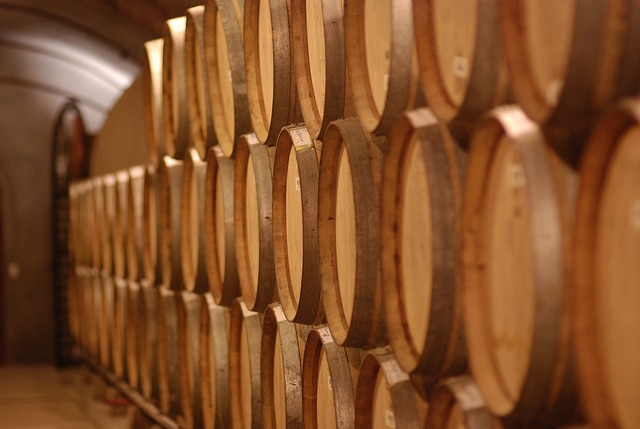
Cooperage
One important factor that goes into the final wine product is what it’s aged in, which is why the Sommelier Society of America holds an entire class on oak and what makes it a great choice for aging wine. Often — but not always — wine is aged in oak barrels in order to extract certain characteristics of the wood that enhance the aroma and mouthfeel of the wine. Additionally, it exposes the wine to air, with reacts with wine compounds and encourages the drink to mature. Other positive qualities of oak in particular include its durability, high tannins (which allow wine to age without going bad), tight grain (which keeps wine from evaporating) and an absence of odors.
Typically winemakers need to decide whether they’re going to use American or French Oak, which affect the wine in very different ways. Let’s first look at American Oak, which at about $400 per barrel is more than 50% less expensive than French Oak, which is approximately $850. American Oak is originally used for bourbon, and the staves — the wooden planks making up the barrel — are oven dried, charred and bent using steam. This leads to a barrel with more aggressive oak flavors and accents of vanilla and coconut, as well as a more assertive mouthfeel.
This is compared to French Oak, which is higher in tannins, with a less obvious oak flavor and smell. These barrels are originally used for wine and air dried for one-to-two years before being fire toasted and bent for a more subtle sensory characteristics.
Knowing these things can give you some clues while you’re wine tasting as to what you’re drinking. For example, American Oak is commonly used for wines like Rioja, Silver Oak, Rombauer Chardonnay, BV Georges de Latour and ZD Wines, while French Oak is what you’ll find with Bordeaux, Burgundy and California wines.
Service
The beginning certification classes with Sommelier Society of America don’t just go into wine tasting through the palate, but also how a wine service should go. It’s much more than simply pulling off that cork and pouring, or letting that Champagne cork pop (don’t ever do this!). The service you provide is part of the entire wine experience for the drinker, making it crucial to understand, especially if you’re working in a restaurant.
Part of the service aspect of wine comes before you even see a guest, as in when you’re storing the wine. There are certain elements you’ll want to keep away from your stored wine to keep it safe, including air, extreme temperatures, large temperature swings, odors, daylight and vibration, as all of these can have a negative impact on the wine. Therefore, your aim should be a dark, well-ventilated and insulated room that’s kept at a constant 55-degrees Fahrenheit in sturdy bins that secure the bottles from rolling. If working in a restaurant, wines should be laid down on the side with the label up, as you may need to gently bring a wine upstairs in a basket and will want the label facing out for the customer.
While there are numerous types of glassware for drinking from, a rule of thumb is a clear, fairly large tulip-shaped glass with a stem. This allows the drinker to appreciate the aromas of the wine without touching the bowl (your body heat can unintentionally warm the wine). After presenting the host/wine selector a 1-1.5 ounce pour of the wine — as well as the cork — the wine should be served clockwise beginning with ladies, then gentlemen then the wine host. Never serve with the label facing down, and fill glasses 1/3 to 1/2 full. Tip: Before serving a wine make sure it isn’t “corked,” which is indicative by a wet paper or soggy cardboard smell.
Over-chilling is one enemy of wine that can kill the aromas, so make sure to chill a wine properly. Fill a bucket with water and ice so that the shoulder of the bottle is submerged. Before guests arrive, keep a white or rose in a cooler for 15 minutes — remember reds are served at room temperature, although Beaujolais is sometimes chilled — and Champagne for about 30 minutes. Typically the sweeter the wine the colder it should be served.
Also check for sediment. In whites “wine diamonds” as they’re nicknamed, which are actually hardened tartaric acid, look like glass, although are harmless. In reds, sediment occurs due to tannins and color pigmentation as the wine ages, and can give the drink a bitter taste (so don’t pour it in). And if the wine looks cloudy, it most often means it’s unfit to drink.
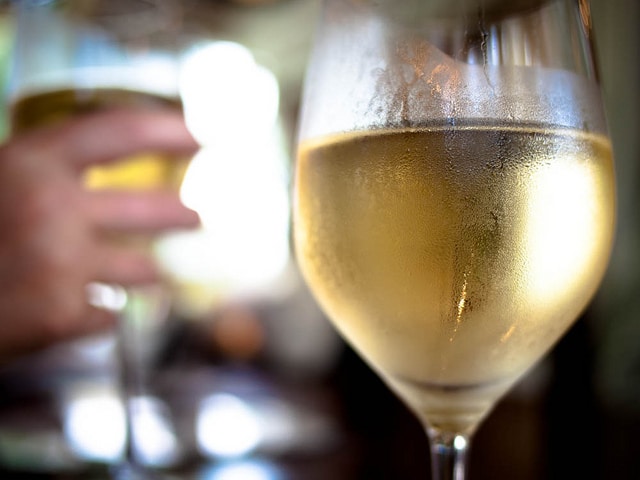
Mind Blown
While the entire class was full of interesting wine information I hadn’t previously known, what really blew my mind was the fact you can make white wine from red grapes. Yes, you read that right. It is entirely possible for both red and white wine to come from the same grape. To understand this it’s important to comprehend that red wine gets its color from the grapes being fermented on their skins, with developing alcohol and enzymes transferred from the skin pigment. On the other hand, white wine is fermented without the skin contact, so no pigmentation gets devolved. Rose is sort of in the middle of these two processes, with the skins staying on but being removed early during fermentation.
Expanding Your Knowledge Of Wine
My favorite part about the Sommelier Society of America certification course is the homework: drink wine. This is how you’re going to learn, by tasting, trying to identify different wine characteristics, attempting to taste blindly, reading the tasting notes as you sip to pinpoint what your tasting, and savoring the various wines from regions all over the world. Whether you’re looking to become a professional or not, this will also help you go beyond 2-Buck-Chuck or the “safe choice” wine you’ve been drinking for years. Figure out what types of wine you like and try types with these characteristics. Most people prefer to start with dry whites before moving on to reds, and light wines before moving on to full bodied choices. Who knows? You may make some life- — or at least palate- — changing discoveries.
Have you ever taken a sommelier certification course? Have some tips on how to appreciate and pinpoint wine characteristics? Please share in the comments below.
Also Check Out:
Epicure & Culture Launches Sustainable Amalfi Coast Tour
Tuscany Travel: A Slice Of Heaven Paired With Chianti Classico Wine At Castello di Gabbiano
Learning The Art Of Traditional Tuscan Cooking
Jessica Festa
Latest posts by Jessica Festa (see all)
- A Culturally-Immersive Adventure In Mongolia’s Altai Mountains - Jul 8, 2023
- This Recipe Sharing Platform Supports Women In The Culinary Industry (Labneh Recipe Included!) - Nov 5, 2020
- Hiking The Mohare Danda Community Eco-Trek In Nepal - Jun 3, 2020
- 6 Important Questions For Choosing A Responsible Yoga Retreat - May 18, 2020
- How To Create & Grow A Profitable Blogging Business (Ethically) - Jan 18, 2020

